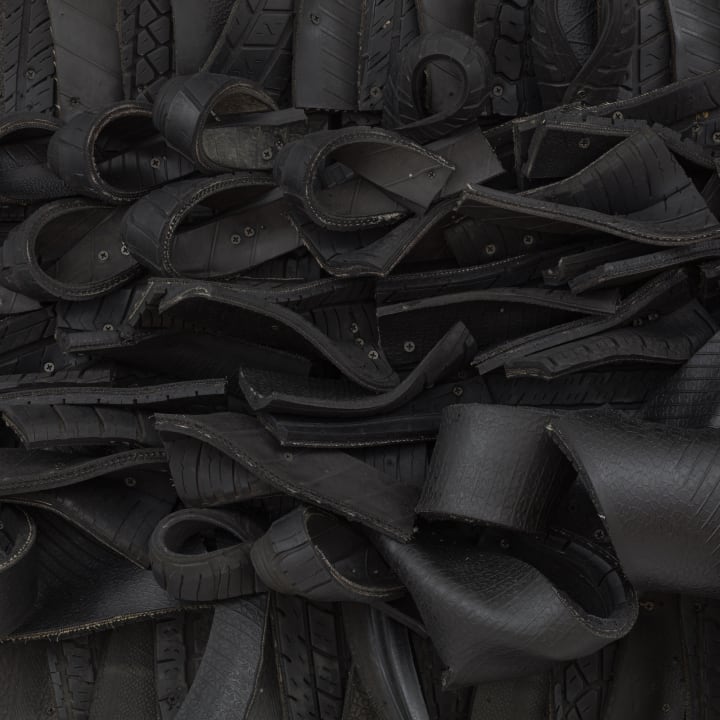CHAKAIA BOOKER: Public Opinion
-
Overview
Public Opinion, Chakaia Booker’s inaugural exhibition with David Nolan Gallery, showcases the artist’s signature approach to abstraction developed over the last four decades. Booker, a fixture of the New York City East Village art scene since the early 1980s, is best known for her pioneering use of recycled rubber tires as a raw material for making abstract sculpture, often at a monumental scale.
As an abstractionist, the essential elements of materiality, modularity, and movement are the key building blocks for all of Booker’s works regardless of media. The pieces assembled for Public Opinion include bronzes, ceramic constructions, paintings, prints, as well as sculptures composed of Booker’s now iconic rubber tires. Booker’s work is often site-specific and site-responsive. Manipulating Fractions, last exhibited in Booker’s solo survey, The Observance, at The Institute of Contemporary Art, Miami in 2021, has been reassembled and reinterpreted in response to the gallery’s architecture and volume. The long running themes or meditations on human desire, struggle, perseverance, hope held back and hope realized present in Booker’s earlier works made of rubber and steel, such as Raw Attraction (in the collection of the Metropolitan Museum of Art), are continued with new works, Conflicting Issues and Minimum Wage.
Booker’s primary material, rubber tires, is conceptually loaded, speaking to issues of environmental destruction, socioeconomic disparity, and access to technology as it relates to modes of transportation. Curators and critics have often linked the material to the artist’s African-American heritage, which Booker acknowledges, adding that the material also speaks to the resilience required for survival for Africans in the diaspora, citing the difficulty in getting traction to move forward and upward versus spinning in circles.
Booker’s titling keeps these multifaceted readings of the work open as exemplified with classic works, It’s So Hard to Be Green (Booker’s monumental contribution to the 2000 Whitney Biennial) and A Moment in Time (2004 work at Storm King Art Center), and new works included in this exhibition, Self Absorbed and Fixed Scale. These conceptual attributes combined with the intrinsic artistic elements of beauty, gesture, and sheer physical presence are why Booker was included in the seminal exhibition at the Metropolitan Museum of Art, Epic Abstraction - Pollock to Herrera, placing the artist rightfully in the company of influential and uniquely identifiable abstractionists Mark Rothko, Jackson Pollock, Ellsworth Kelly, Carmen Herrera, Helen Frankenthaler, Thornton Dial, Louise Nevelson, and Cy Twombly.
Modularity is essential to understanding Booker’s work, whether in sculpture, painting, or printmaking. The ability to build textures, movements, and forms through repetition not only creates rich, tactile, and seductive surfaces, it draws parallels to industrialization, textiles for fashion, and cultural homogenization; hallmarks of the American middle class and American dream. In this way Booker’s abstract works, in art historical terms, live between the gestural and repetitious world of Jackson Pollock and the constructed architecture of Louise Nevelson with an inventiveness reminiscent of fellow abstractionists Sam Gilliam and Thornton Dial. Modularity solves creative problems of achieving a large scale with work and allows for near infinite possible variations on a theme. This approach to making frees a single mark or segment of a pattern from being locked into a single location or context. For Booker, modularity is liberating and integral in developing rhythm within a work and within its viewing. The flow and movement inherent in each piece is how Booker pulls the audience in, encouraging viewing in the round. Booker’s work is visually lyrical, revealing itself over time, instigating conversation.
- Phil Sanders
-
Installation Views
-
-

-

-

-
 Chakaia BookerSplitting Memories, 2022rubber tires and wood36 x 20 x 11 1/2 in (91.4 x 50.8 x 29.2 cm)
Chakaia BookerSplitting Memories, 2022rubber tires and wood36 x 20 x 11 1/2 in (91.4 x 50.8 x 29.2 cm) -

-

-

-

-

-

-

-

-

-

-

-
 Chakaia BookerUntitled, 2013woodcut and hand-painted multilayered chine-collé collage
Chakaia BookerUntitled, 2013woodcut and hand-painted multilayered chine-collé collage
unique30 1/4 x 38 3/4 in (76.8 x 98.4 cm) -
 Chakaia BookerUntitled, 2022lithography and chine collé with embossment30 1/2 x 38 1/2 in (77.5 x 97.8 cm)
Chakaia BookerUntitled, 2022lithography and chine collé with embossment30 1/2 x 38 1/2 in (77.5 x 97.8 cm) -

-

-

-

-
-
PRESS
-
Spotlight: Artist Chakaia Booker’s Rubber Tire Sculptures Sit at the Intersection of Culture, Economics, and Transportation
Artnet Gallery Network · Artnet June 14, 2023What You Need to Know: American artist Chakaia Booker—widely recognized for her extensive use of recycled rubber tires in her work—is currently the subject of a solo show with David... -
Chakaia Booker: Public Opinion
Alfred MacAdam · Brooklyn Rail June 1, 2023Chakaia Booker is a busy artist. On any given workday she paints, sculpts, and makes prints—seemingly all at the same time. Examples of all three media are crammed into the...
-
-
Artist
























